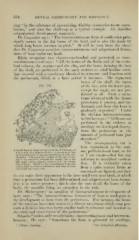Page 568 - My FlipBook
P. 568
578 DENTAL EMBRYOLOGY AND HISTOLOGY.
ring " in the substance of pre-existing fibrillar connective-tissue mem-
branes," and cites the skull-cap as a typical example. He classifies
subperiosteal development separately.
l)r. Carjjenter says : " The intermembranous fijrm of ossification prin-
cipally occurs in the flat bones of the head, and is also the mode by
which long bones increase in girth." It will be seen from the above
that Dr. Carpenter considers intermembranous and subperiosteal forma-
tions of bone under one head.
Klein recognizes two classes—enchondral and periosteal, or inter-
membranous—and says : "All the bones of the limbs and of the verte-
bral cohunn, the sternum and the ribs, and the bones forming the base
of the skull, are preformed in the early embryo as solid hyaline carti-
lage covered with a membrane identical in structure and function with
the periosteum, which at a later period it becomes. The tegmental
bones of the skull, the l)ones
Fig. 318. of the face, with the lower jaw,
except the angle, are not pre-
formed at all. Only a mem-
brane identical with the future
periosteum is present, and un-
derneath and from this bone is
gradually deposited." Under
the division intermembranous
he further says : " All bones not
preformed in the embryo as
cartilage are developed directly
from the periosteum in the
manner of periosteal bone just
described."
The accompanying cut is
here reproduced as the only
A Small >rass of Bone-substance in the Periosteum of one pul)lished—at least, so far
Lower Jaw of a Human Fa'tus: a, osteogenetic lay-
er of periosteum ; //, multinucleated giaut-cells, niy- as I am aware—that has any
eloplexes. The one in the niicldle (jf the ujtper mar-
gin is an osteoclast, whereas I he smaller one to the reference to maxillary ossifica-
left upper corner appears concerned in the forma-
tion of hone. Above (e) the osteoblast-cells become tion. It is evidently taken
surrounded by osseous substance, and thus become from a quite mature foetus, as
converted into bone cells.
osteoclasts are figured, and they
do not make theii" appearance in the jaws until very near birth, at which
time a jieriosteum has been difierentiated and subperiosteal bone-forma-
tion is in active progress ; this is also the case in all the bones of the
body, the maxillje being no exception to the rule.
Dr. Shakespeare,^ in speaking of intramembranous development of
bone, says : " The intermembranous formation of bone is analogous to
the development of bone from the periosteum. For instance, the bones
of the cranium have their origin in a fibrous membrane which soon })re-
sents a division into two layers similar l)()th in structure and function to
the outer and iimer layers of the periosteum."
Schaefer^ makes only two divisions—intercartilaginous and intermem-
branous. He says : " Sometimes the bone is preceded by cartilage,
'
' Allen's -l?»o


